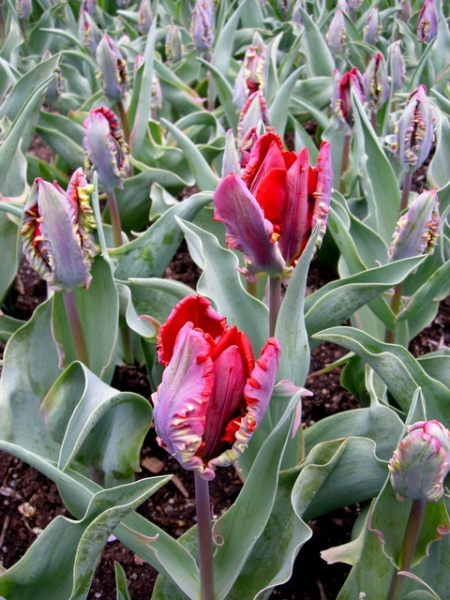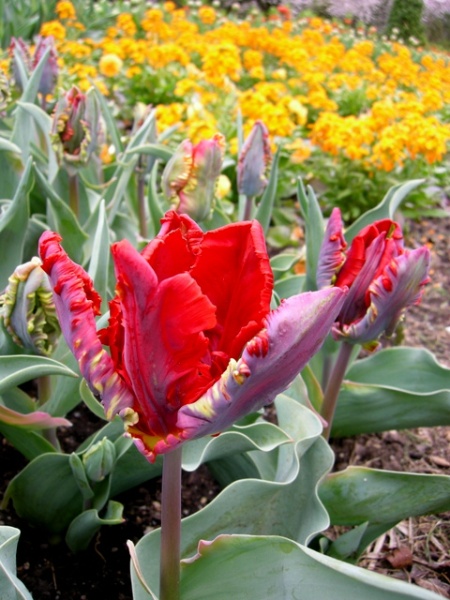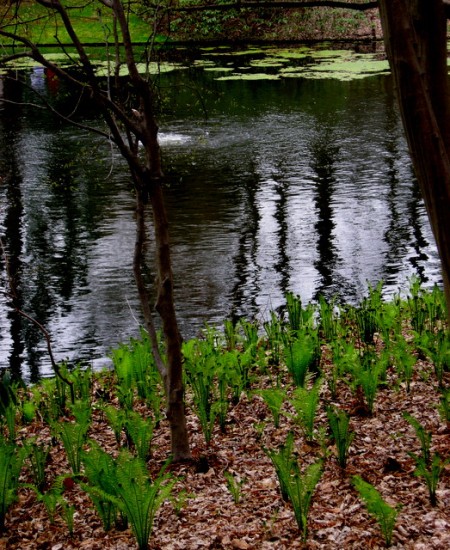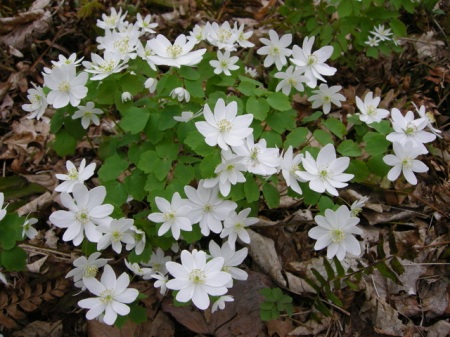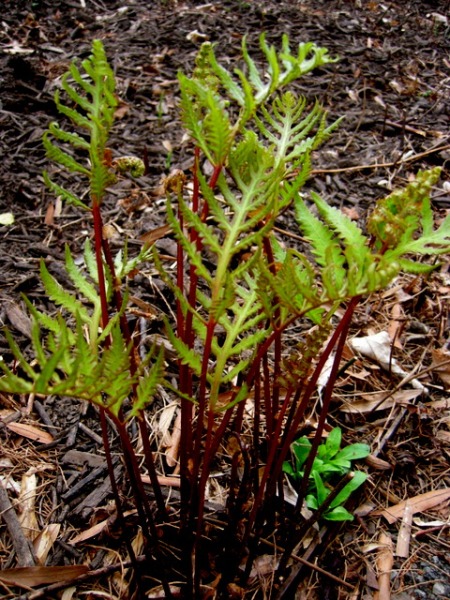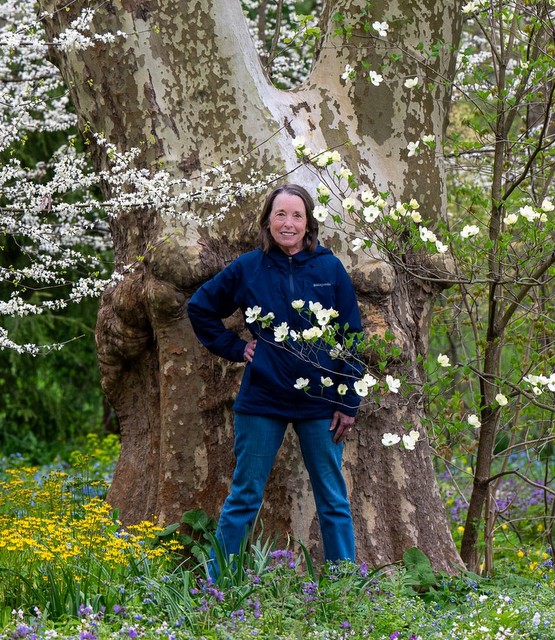 The woodland at Carolyn’s Shade Gardens with mayapples, golden groundsel, Viginia bluebells, dwarf Jacob’s ladder, wild ginger, and white-flowered redbud, all native to Pennsylvania in the mid-Atlantic US.
The woodland at Carolyn’s Shade Gardens with mayapples, golden groundsel, Viginia bluebells, dwarf Jacob’s ladder, wild ginger, and white-flowered redbud, all native to Pennsylvania in the mid-Atlantic US.
I am very excited to report that my blog has now gone over 2 million views. To see the numbers, look at the counter on the right sidebar labeled Site Stats Since 11/3/10 (if the sidebar is not visible, click the snowdrop banner at the top). That’s a lot of people! And what have they been reading? Well, my fifth most popular post is Your Native Woodland: If You Build It They Will Come, which I wrote in April 2012. In it, I tell readers how to create their very own woodland filled with native plants. To read it, click here.
Nursery News: Carolyn’s Shade Gardens is a retail nursery located in Bryn Mawr, PA, specializing in showy, colorful, and unusual plants for shade. The only plants that we ship are snowdrops and miniature hostas. For catalogues and announcements of events, please send your full name, location, and phone number (for back up use only) to carolyn@carolynsshadegardens.com. Click here to get to the home page of our website for catalogues and information about our nursery and to subscribe to our blog.
.
 Photos of the six of the native plants recommended in the 2012 post, clockwise from the left: Celandine poppies and Virginia bluebells, dwarf Jacob’s ladder and wild ginger, ‘Blue Ridge’ creeping phlox, and northern sea oats.
Photos of the six of the native plants recommended in the 2012 post, clockwise from the left: Celandine poppies and Virginia bluebells, dwarf Jacob’s ladder and wild ginger, ‘Blue Ridge’ creeping phlox, and northern sea oats.
In 2012, I recommended that readers use nine plants to create their native woodland: Virginia bluebells, Celandine poppy, dwarf Jacob’s ladder, white violets, creeping phlox, wild ginger, golden groundsel, and northern sea oats. All the botanical names are in the original post. I still believe that those nine plants are the best natives to start your woodland because they are beautiful, easy to grow, and spread quickly.
.
 Photos of the remaining three native plants recommended in the 2012 post, clockwise from upper left: white violets, blue wood aster, and golden groundsel.
Photos of the remaining three native plants recommended in the 2012 post, clockwise from upper left: white violets, blue wood aster, and golden groundsel.
I am hoping that after five years, gardeners have been successful with the original nine recommendations and are ready to broaden their selection. Below, I profile eight more easy-to-grow native plants. Keep in mind that the more plants of each variety you plant, the more satisfied you will be with the result. If you are on a budget, plant five, seven, or nine of one or two of the recommendations rather than a smaller quantity of each. Use plenty of compost and mulch with ground or whole leaves, and then stand back and watch them spread.
Here are my suggestions for additions:
. Foamflower, Tiarella cordifolia, thrives in high shade and well-drained soil. Here it is with blue wood aster right under my massive black walnut trees.
Foamflower, Tiarella cordifolia, thrives in high shade and well-drained soil. Here it is with blue wood aster right under my massive black walnut trees.
.
 Last time I recommended ‘Blue Ridge’ creeping phlox, but purple and pink creeping phlox are even more vigorous. This is my sweep of the purple variety, Phlox stolonifera ‘Sherwood Purple’. It really likes edges so plant it along your woodland path.
Last time I recommended ‘Blue Ridge’ creeping phlox, but purple and pink creeping phlox are even more vigorous. This is my sweep of the purple variety, Phlox stolonifera ‘Sherwood Purple’. It really likes edges so plant it along your woodland path.
.
.
 Creeping phlox also comes in pink—the cultivar ‘Home Fires’.
Creeping phlox also comes in pink—the cultivar ‘Home Fires’.
.
 Native sedge, Carex laxiculmus ‘Bunny Blue’, grows right at the base of trees and reproduces itself nicely, spreading its beautiful silver-blue hue around the woods.
Native sedge, Carex laxiculmus ‘Bunny Blue’, grows right at the base of trees and reproduces itself nicely, spreading its beautiful silver-blue hue around the woods.
.
 This is a western native camassia, C. leitchtlinii ‘Caerulea’. It grows through out my woodland in filtered light but also in my part sun meadow. Each plant increases to a gorgeous clump and blooms in May.
This is a western native camassia, C. leitchtlinii ‘Caerulea’. It grows through out my woodland in filtered light but also in my part sun meadow. Each plant increases to a gorgeous clump and blooms in May.
.
 A very unusual native plant called Robin’s plantain, Erigeron pulchellus ‘Lynnhave Carpet’, makes a tight ground cover of fuzzy gray leaves at the edge of my woods. In May, it produces multitudes of daisy like flowers. This patch started from a single plant given to me by Charles Cresson.
A very unusual native plant called Robin’s plantain, Erigeron pulchellus ‘Lynnhave Carpet’, makes a tight ground cover of fuzzy gray leaves at the edge of my woods. In May, it produces multitudes of daisy like flowers. This patch started from a single plant given to me by Charles Cresson.
.
 There are many ferns that thrive in my woods but none do as well as ghost fern. It is a native hybrid (lady fern x Japanese painted fern) rather than a straight native, but it makes up for its non-native heritage with its beautiful silvery gray leaves and striking upright habit.
There are many ferns that thrive in my woods but none do as well as ghost fern. It is a native hybrid (lady fern x Japanese painted fern) rather than a straight native, but it makes up for its non-native heritage with its beautiful silvery gray leaves and striking upright habit.
.
 Your woods wouldn’t be complete without understory trees, and nothing works better than our Pennsylvania native redbuds. I use white-flowered redbud, Cercis canadensis ‘Alba’, in my woods because I love blue, yellow, and white together. ‘Alba’ is pictured here with yellow trillium, Virginia bluebells, and Celandine poppy.
Your woods wouldn’t be complete without understory trees, and nothing works better than our Pennsylvania native redbuds. I use white-flowered redbud, Cercis canadensis ‘Alba’, in my woods because I love blue, yellow, and white together. ‘Alba’ is pictured here with yellow trillium, Virginia bluebells, and Celandine poppy.
.
 White redbud with native hardy geranium, ginger, Virginia bluebells, cinnamon fern, mayapples, and golden groundsel.
White redbud with native hardy geranium, ginger, Virginia bluebells, cinnamon fern, mayapples, and golden groundsel.
.
Carolyn
.
Nursery Happenings: You can sign up to receive catalogues and emails about nursery events by sending your full name and phone number to carolynsshadegardens@verizon.net. Subscribing to my blog does not sign you up to receive this information. Please indicate if you will be shopping at the nursery or are mail order only.
Carolyn’s Shade Gardens is a local retail nursery in Bryn Mawr, Pennsylvania, U.S., zone 6b/7a. The only plants that we mail order are snowdrops and miniature hostas and only within the US.
Facebook: Carolyn’s Shade Gardens has a Facebook Page where I post single photos, garden tips, and other information that doesn’t fit into a blog post. You can look at my Facebook page here or click the Like button on my right sidebar here.
Notes: Every word that appears in orange on my blog is a link that you can click for more information. If you want to return to my blog’s homepage to access the sidebar information (catalogues, previous articles, etc.) or to subscribe to my blog, just click here.




























